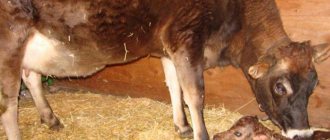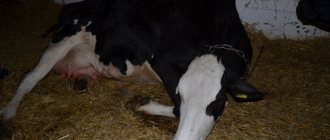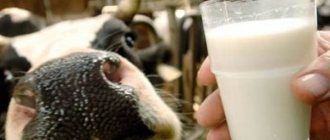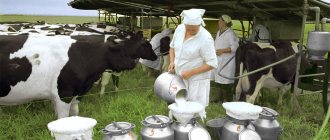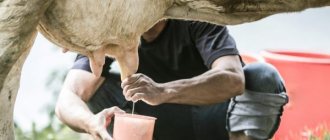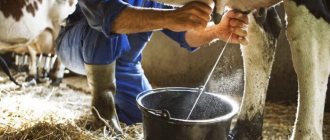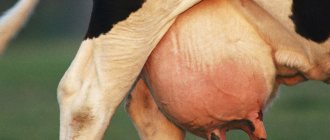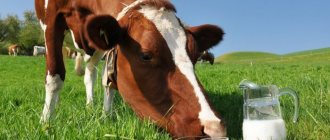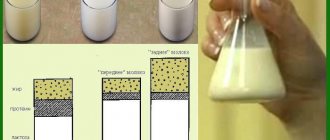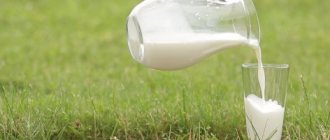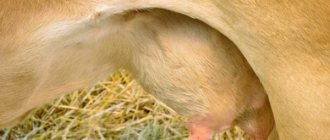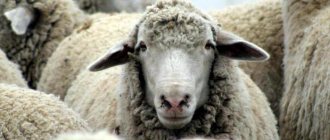How to test milk for somatic cells without a mastitis test
There are many different rapid tests for checking for mastitis in the veterinary pharmacy or on the Internet: Kenotest, Mastidine, Mastoprim and others. But if it is not possible to buy such a test system, you can take ordinary dish soap, liquid soap, etc.
The only condition for proper testing is that the approximate percentage composition of surfactants (surfactants) is indicated on the packaging. Here is a video comparing the results of the rapid test and detergents.
How to prepare a substance for home testing for mastitis
If there are approximately 20% surfactants in the detergent, then you need to dissolve it in boiled water 1:1, and then mix this solution with milk in equal parts and shake for 30 seconds. When surfactants are 10%, there is no need to dilute with water.
Determination of mastitis in cows using a dishwashing detergent test. The concentration of surfactants is approximately 2 times higher than in Mastidine
In case of inflammation, surfactants will bind somatic cells and the milk will become viscous, mucous, similar to liquid jelly, or will form a clot.
Note(!): This inexpensive method is not suitable for all types of mastitis. That is, only mucus in milk can be detected, which is indirectly a sign of some mastitis.
In general, somatic cells, consisting of the epithelium of the udder, leukocytes, and even erythrocytes, can increase in size for various reasons. A mucous clot does not necessarily indicate an inflammatory process in the lobe.
What is the principle of operation of the detergent - can it be trusted?
Matidine, for example, which is used to test for mastitis, is the same surfactant solution (10%). Additionally, it also contains an acidity indicator. The more somatic cells, the denser and more viscous the clot will be. The higher the acidity of the milk, which means there are more hydrogen ions in it, the brighter the color of the indicator.
Homemade dishwashing detergent is also a surfactant solution. Prepare it in the right proportion and get the effect of a real veterinary express test.
Treatment at home
When treating mastitis in cows, it is necessary to take an integrated approach.
First of all, the process of combating the disease must necessarily include drug therapy using drugs such as antibiotics. Physiotherapy and topical preparations in the form of ointments are also used to treat mastitis in cows. In addition, there are a number of folk recipes for treating this disease.
What to do: general measures
Important! An animal diagnosed with mastitis is separated from the herd, excluding walking and preparing a well-ventilated room for it with a constant and comfortable air temperature. It is important to keep the litter clean and dry to avoid the spread of bacteria.
To reduce milk production, the cow is given less water and succulent feed, and to reduce swelling, soreness and the removal of microorganisms, pumping is carried out at least 4, and preferably 6 times a day.
All procedures are performed only with disposable instruments and sterility is carefully monitored, otherwise there is a risk of complications.
Drug therapy
Drug treatment involves the use of hormonal and antibacterial agents. In the first group, the drug “Oxytocin” is most often used - it is injected into the jugular vein after milking to stimulate contraction of smooth muscles. Prednisolone is used to reduce swelling and pain.
Oxytocin is not prescribed to pregnant animals due to the stimulation of premature calving.
Antibacterial drugs (“Mastiet-Forte”, “Tetra-Delta”) are injected directly into the udder.
To reduce pain, use novocaine blockade, in case of high body temperature - antipyretics, and to wash the udder - streptocide solution.
Use of drugs
Reference. Antibiotics are selected based on the results of a microflora study, therapy lasts 4–5 days. During this time and 5 days after stopping treatment, the resulting milk should not be consumed.
Methods of administering antibiotics:
- intramuscularly - drugs "Bicillin-5" or "Nitox" (prescribed for catarrhal and purulent mastitis);
- through a catheter - “Penersin”, “Masticide”, “Mastisan”;
- directly into the udder after expressing milk - “Mastisan” or “Gamaret” (catarrhal and purulent inflammation).
When pathogenic bacteria are detected, the following is prescribed:
- "Benstrep" - fights gram-positive bacteria;
- "Pencimin" - to combat various pathogenic microorganisms;
- "Maximax" - kills streptococci and staphylococci;
- "Penicillin" - active against gram-positive and gram-negative bacteria;
- "Monomycin" - prevents the development of protozoa;
- "Erythromycin" - against aerobic bacteria, streptococcus and staphylococcus.
In advanced cases, a combination of drugs is prescribed, for example, Penicillin and Streptomycin or Neomycin and Tetracycline.
Vitamins, probiotics
To restore the natural intestinal microflora after the use of medications, probiotics are used - “Bacell”, “Monosporin”. Intramuscular administration of vitamins C, A, E, B12 is designed to increase immunity, improve peristalsis and remove toxins from the body.
How to treat with folk remedies?
As a supplement to the main treatment, the use of folk remedies is acceptable. To relieve the symptoms of mastitis, apply to the udder:
- cabbage leaves;
- grated carrots;
- tea mushroom;
- aloe vera gel;
- coltsfoot leaves.
Clay applications
White and red clay are mixed with a decoction based on nettle, yarrow and plantain, the cow's udder is lubricated with the resulting mixture and left overnight. In the morning, the mammary glands are washed with a warm infusion of nettle and dandelion.
The product has an antibacterial effect, helps fight catarrhal and fibrous forms of mastitis, helps relieve swelling and relieve pain.
Eucalyptus ointment
A mixture of eucalyptus leaves, soap grass and Japanese acacia (4 tbsp each) is poured into a glass of water, boiled for 5 minutes, infused and filtered, and 100 g of butter is added to it. The resulting ointment is lubricated on the udder to relieve inflammation and reduce pain.
Important! Warming up and using hot compresses is prohibited - this promotes the growth of microbes.
Massage
Before milking, the udder is gently massaged. The massage technique depends on the type of disease, but there are general rules:
- movements must be smooth, the use of force is unacceptable;
- perform circular movements in the area of inflammation;
- the udder is kneaded without pressure and over the entire area;
- I massage the nipples individually, pointing them upward.
Massage is prohibited in serous, fibrous and catarrhal forms of the disease - in these cases, breaking the seals leads to the spread of infection.
Physiotherapy
To warm the udder and stimulate the resorption of clots, the mammary glands are lubricated with ichthyol and heparin ointments, Vishnevsky ointment is placed on the udder as a compress, and camphor oil is used during milking. Warming up with an infrared and mercury-quartz lamp, electrophoresis is effective.
Below is a video about the treatment of mastitis in cows, starting with a barely noticeable, subclinical form of the disease:
The somatic level of the test is increased - is it necessary to treat mastitis immediately?
A clot is not a direct guide to action, but only a signal to pay attention, to take a closer look at the animal. In this case, we evaluate the udder, milking, straining and settling of milk.
Udder
Is everything okay with the udder?
or there are visible changes: redness, swelling, pain, uneven structure, compaction. Are there any visible damages or wounds (the website has a detailed article about cracks and wounds on the nipple).
If there are no visible violations, and this is exactly what happens with subclinical (unexpressed) mastitis or at the very beginning of inflammation, you need to check how the milk and the strainer are milked.
What to look for when milking a cow
Any changes compared to the normal milking process should alert you.
For example, milk flows poorly, slower, with clots and mucus. A cow may reduce milk during mastitis.
The animal kicks during milking or some kind of lump is felt in the nipples. If you notice moving balls in your nipples, it means it’s a milk stone (read more about how to remove them here).
We analyze the filter for the presence of additional inclusions
Regardless of whether you milk by hand or with a machine, before milking, be sure to give several streams of milk from each share to check.
Pay attention to whether there are any casein clots (allowed 1-2 weeks after calving), grains, flakes, mucus, or blood on the strainer. Is there any unpleasant smell?
Mastitis milk is not used for food - everything is discarded. Therefore, in order not to ruin the entire milk yield (from sick and healthy lobes), be sure to check the first streams of milk before manual milking or connecting milking cups
.
Hint(!):
Any dishwashing detergent or washing powder, when washed with it, shows mucus, sometimes even when there is no change in the udder, during milking and in the form of milk. The mucus on the straining fabric becomes noticeable to the hands - this is a reason to suspect something is wrong.
How milk and fermented milk products change during mastitis
An unusually rapid souring of milk should alert you. Note the appearance:
- atypical odor during souring;
- suddenly decreased cream sediment by 50-150%;
- if the sour cream turns out sticky and sticky;
- when the cottage cheese either doesn’t work out at all, or the yield is small and the cottage cheese is “rubbery”;
- When milk is separated, a thick coating, including blood, remains on the drum.
From experience(!):
In general, during separation, many milk defects are visible, including mastitis at an early stage, when it is not visible by other signs.
Any of these signs, or a combination of several signs, most likely indicates possible mastitis or other physiological diseases (ketosis, acidosis, and others).
Bacteriological research
Mastitis tests confirmed subclinical mastitis in the herd. In this case, it is advisable to conduct a bacteriological study to identify pathogenic microflora. To carry it out, you need to take milk from those affected quarters. Ten milliliters of product is also sufficient.
- Add 0.2 milliliters of milk to the surface of solid nutrient media - Endo, Levin, ZhSA (yolk-salt agar), Sabouraud, blood agar.
- A similar volume is added to liquid nutrient media - selenite and sugar broth.
- The crops are kept at a temperature of 370C for a day, only for ZhSA - for two days and for Saburo - for five days.
- After 24 hours, seeding of the media is carried out using a loop on special dense media. This is Ploskirev's medium and Bismuth-sulfite agar. After this, the number of colonies formed is calculated. In some cases, these may be small gram-negative rods with round tips. And sometimes these are gram-positive cocci, scattered chaotically one at a time or together.
- Microbiology allows this method to identify streptococcal mastitis in cows.
More on the topic: Characteristics of Voronezh cow breeds
Using disc methods, the appropriate antibiotic for treatment is selected. To do this, add twenty milliliters of molten agar medium to clean Petri dishes. When it hardens, one milliliter of bacterial suspension is introduced. The mass is carefully poured throughout the medium. You can apply milk to it and spread it with a spatula throughout the entire volume.
After this, you need to let the medium dry using high temperatures. The antibiotic should be applied on disks to the dried medium.
About five drugs are diagnosed in each Petri dish. They are left in the room for a short time, and then turned over at a temperature of 370C for seventeen hours. The result will be a proliferation of bacteria around the discs. If they do not grow, then sensitivity to the antibiotic is low.
Mastitis in cows
February 21, 2017
Udder mastitis in cows is the number one problem in modern dairy farming. Mastitis causes serious economic damage to this entire industry. After all, due to mastitis, milk yield sharply decreases. In addition, milk from sick animals is generally prohibited for consumption. On some farms, up to 35% of animals can suffer from mastitis at once.
Until recently, mastitis in cows was treated only with antibiotic therapy. But treatment with antibiotics had a significant drawback: antibacterial drugs tend to accumulate in animal cells. The presence of antibiotics is also found in milk, making it unsuitable for the food industry. Therefore, previously it was necessary to wait another 5-6 days after the animal’s recovery to begin full milk collection. Now, faster and more comprehensive methods have emerged to cure mastitis in cows.
Causes and symptoms of mastitis in cows
The main causes of mastitis in cows are: diseases of the genital organs, damp bedding, udder bruises, drafts, violation of milking rules, unsanitary conditions for keeping the animal, as well as poor udder hygiene.
If the animal is kept in poor conditions, then microbes from the skin and dirty bedding penetrate into the udder. The likelihood of developing mastitis increases if the teats on the udder or the skin are damaged. Acute forms of mastitis in cows are very easy to diagnose: protein clots appear in the milk (often mixed with blood), the udder becomes hot, swollen and painful, and the animal becomes lethargic. There is an increase in temperature and a decrease in appetite. Swelling of the udder often spreads to adjacent tissues and an abscess begins. Gangrene of the udder may develop, which often leads to the death of the animal. However, in 95% of cases, mastitis in cows occurs in a chronic form. In this case, the fat content of milk becomes lower. The milk acquires a heterogeneous, watery consistency. Clots and flakes are visualized in it. Sometimes the appearance of the milk is quite satisfactory, but upon palpation of the cow’s udder, compactions are determined, which indicate a chronic inflammatory process inside the mammary gland.
Types of mastitis in cows
Based on the severity of the disease and clinical picture, the following types of mastitis in cows are distinguished:
- subclinical mastitis. Without special tests, it is quite difficult to determine this disease. Inflammation of the mammary gland occurs unnoticed, and the milk looks normal. Hidden mastitis in cows cannot be diagnosed based on external symptoms. To accurately make a diagnosis, it is necessary to count somatic cells and analyze the flora that is released along with milk from the animal’s udder. If subclinical mastitis is not detected in time, then after a few months the disease will develop into clinical mastitis. Depending on the pathogen that can cause subclinical mastitis, this disease occurs in herds in 2-10 times the proportion of clinical mastitis;
- acute serous mastitis. Serous mastitis in cows can develop immediately after calving. In this case, the cow experiences redness, swelling and swelling of the udder. The affected part of the mammary gland becomes thick and hot. Mastitis in a cow after calving reduces milk yield. The milk becomes watery, patchy, and may contain white flakes;
- catarrhal mastitis. Catarrhal mastitis in cows can develop throughout the entire lactation period, but more often it occurs in the first weeks of milking the animal. In this case, inflammation of only one quarter of the mammary gland begins. At the same time, the udder looks healthy. When palpating the udder and nipples, no deviations from normal are often detected. However, on the 3-5th day of mastitis development, small, pea-sized nodules can be found at the base of the nipple. Sometimes the nodules near the nipple can reach the size of a pigeon's egg. They are formed due to blockage of the milk ducts with milk clots. The general condition of the animal is quite satisfactory. Milk yield decreases, and the milk itself becomes thinner and may contain casein flakes. Sometimes clots appear in the milk, which have difficulty passing through the nipple canal;
- purulent mastitis. Purulent mastitis in cows is characterized by an increase in the volume of the affected part of the udder. It is painful and has a higher temperature. The milk becomes watery, salty and yellowish due to impurities of pus. The animal becomes lethargic and refuses to eat. A cow's body temperature can rise to 40-41 degrees;
- clinical mastitis. Clinical mastitis in cows can be noticeable without laboratory testing. The milk comes out in lumps and flakes, making it unfit for consumption. The clots present in milk are formed by casein, leukocytes and epithelium. Despite the pronounced symptoms, mastitis is not very acute. With moderate mastitis, the udder becomes painful, swollen and hard. The temperature of the part of the mammary gland where there is a focus of inflammation increases. Udder edema develops due to blockage of the milk ducts with clots, which prevent the free flow of milk from the alveoli. If mastitis is not treated, clinical signs become more pronounced. The source of inflammation spreads to the entire udder, and an abscess may develop;
- hemorrhagic mastitis. Hemorrhagic mastitis in cows is an acute inflammation of the udder, which is characterized not only by the discharge of pus, swelling and redness of the cow’s mammary gland, but also by hemorrhages into the tissue, milk ducts and the lumen of the alveoli. Hemorrhagic mastitis is one of the complicated forms of catarrhal mastitis. The disease often occurs in the first days after calving. In this case, half of the udder is affected at once. Hemorrhagic mastitis causes an increase in local temperature and swelling of the udder. In this case, the skin becomes covered with purple spots. The cow's milk becomes watery, reddish and contains casein flakes. When examining a cow, a depressed state of the animal is observed, characterized by lethargy, decreased appetite and increased body temperature. The nipples become swollen and swollen, and the affected part of the udder becomes enlarged and dense. Milk yield decreases even from healthy parts of the udder;
- fibrous mastitis. Fibrous mastitis in cows is accompanied by an increase in the volume of the affected part of the udder. Determination of mastitis in cows is carried out tactilely. When touched, a lump is felt and pain is noted in the mammary gland. Body temperature can rise to 40-41 degrees. The animal has no appetite. Milk yield decreases sharply from the first days of the disease. Yellow crumbs and clots are found in the milk. The milk turns yellow-green due to the pus present. 3 days after the onset of the disease, lactation stops. When milking, only whey and a small portion of pus are released. Even with timely treatment, milk production is not completely restored;
- purulent catarrhal mastitis. Purulent catarrhal mastitis in cows is accompanied by cessation of lactation or a sharp decrease in milk yield. The affected area of the mammary gland does not produce milk at all, or it becomes salty, bitter and watery. Curds appear in the milk. Often the milk takes on a reddish tint. The temperature in the mammary gland increases. The affected quarter of the udder becomes swollen and reddish. The superior lymph node becomes enlarged. The animal has no appetite, and breathing and pulse increase. After some time, the body temperature rises to 40-41 degrees. After 4 days, the symptoms of the acute disease weaken. Acute mastitis resolves or becomes chronic;
- chronic mastitis. With chronic mastitis in cows, milk, as a rule, meets the norm. The inflammatory process proceeds unnoticed. The number of pathological bacteria is reduced. But even with a decrease in somatic cells, infection of the udder can continue for a long time. An untreated infection can cause not only the symptom of inflammation, but also the regrowth of somatic cells.
Treatment of mastitis in cows
With mastitis, not only the udder is affected, but the entire animal as a whole. Therefore, treatment of mastitis in cows should be aimed at eliminating the infectious process with the help of antibiotics, improving the general condition of the animal, increasing immunity and preventing relapses of mastitis. From this point of view, complex therapy is the most acceptable.
In case of acute mastitis, it is necessary to free the mammary gland from bacteria as soon as possible. To do this, you should pump every 2 hours. To mobilize the animal’s defenses, it is recommended to irrigate the surface of the affected udder with cold water 5 times a day to cause hyperemia. Each time after the procedure, you should carefully express the milk and massage the udder by shaking or stroking towards the nipples.
Some experts pour solutions of potassium permanganate (1:300-500), ethacridine lactate, 2% streptocide and 1-3% ichthyol into the udder. Mastitis medications should not be administered to cows under pressure or more than 250 ml at a time, as this may contribute to the spread of microbes into healthy lobules. Irrigation is carried out 2-3 times a day using a milk catheter, which, in turn, is connected to a syringe, a rubber tube with a funnel, or a Bobrov apparatus.
After injecting the solution, the udder is lightly massaged. Such a massage is needed so that the solution spreads faster through the tissues of the affected quarter. The medicine for mastitis in cows is left in the mammary gland for several hours, and then the udder is expressed every hour.
A positive effect in the treatment of mastitis is achieved from autolactotherapy. In this case, subcutaneous injections of sterilized secretion from the diseased quarter are performed. The secretion is administered in small portions of 5-10 ml every 48 hours. In this case, autolactotherapy is combined with the infusion of a two percent sodium chloride solution or a salt-soda solution into the mammary gland. After the infusion, the udder is massaged and the solution is left in it for 40 minutes, and then expressed every two hours.
It is also recommended to administer intravenously 300-400 ml of a one percent solution of streptocide at equal intervals of 24-48 hours or in a smaller volume (50-100 ml) every 5 hours in combination with frequent compression.
Today there is a wealth of material on the treatment of mastitis in cows with antibiotics. Some drugs can be used for 2-3 days. The medicine quickly penetrates the cells and concentrates in them for 7 days. However, in the case of purulent chronic mastitis, when connective tissue growths appear with obliteration of the milk ducts and atrophy of the udder parenchyma develops, treatment with antibiotics has no effect. The affected part of the gland is not restored, and serves as a provoking factor for the spread of microbes to the entire udder of the sick cow. In this case, it is advisable to inject 200 ml of a one percent lapis solution or 100 ml of a five percent iodine solution into the mammary gland.
Prevention of mastitis in cows
A set of preventive measures to prevent mastitis in cows includes:
- strict selection and training of livestock workers;
- proper arrangement of dairy complexes and farms;
- organization of proper maintenance and feeding of animals;
- strict adherence to the rules of milking and animal care;
- maintaining the barn in order and timely cleaning of the surrounding areas;
- regular examination of cows by a veterinarian;
- timely detection of diseases of the digestive organs and reproductive system of animals, as well as their timely treatment;
- prevention and treatment of breast edema during the prenatal and colostrum period;
- constant selection and genetic work aimed at increasing the resistance of cows to mastitis of various etiologies;
- observance of personal hygiene rules by service personnel.
Remember - mastitis can always be avoided! Products for the care of cattle and in particular for the care of the udder can be found in the sections of the catalog of the Unitary Enterprise "Extraservice"
